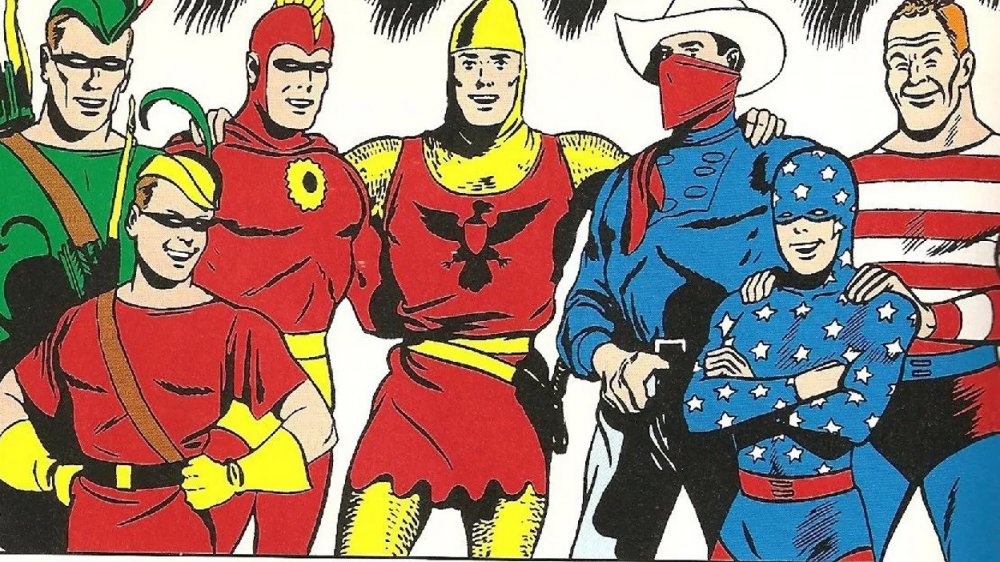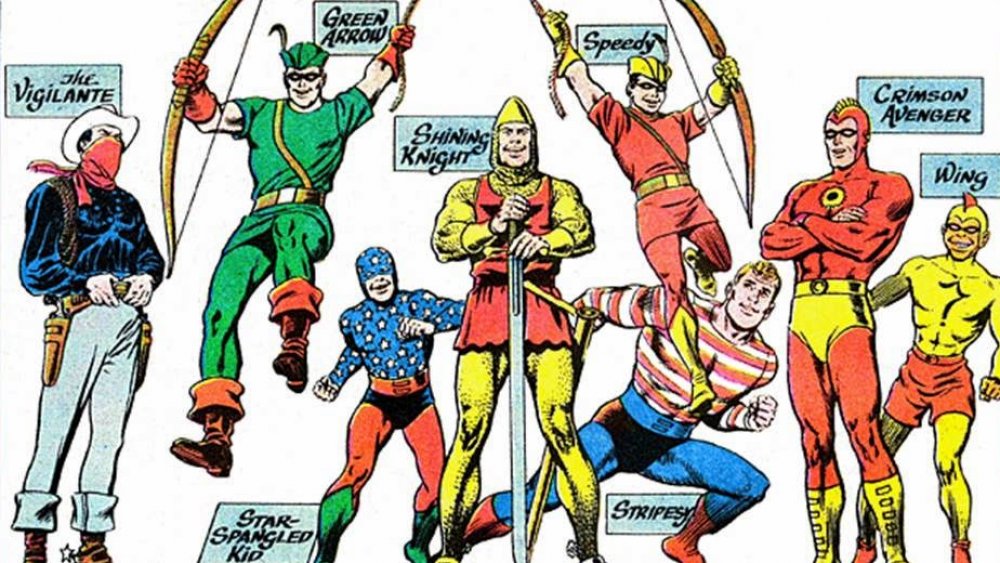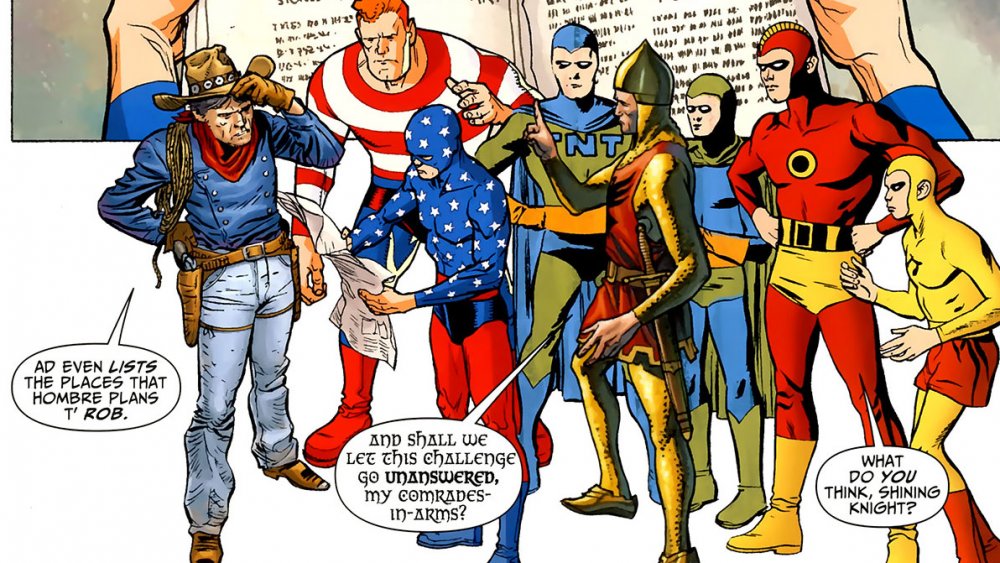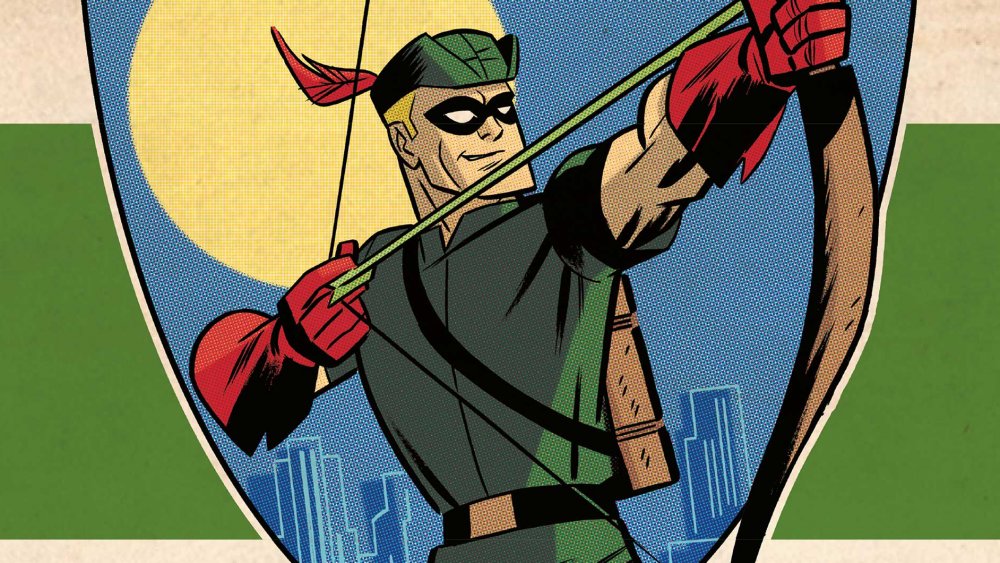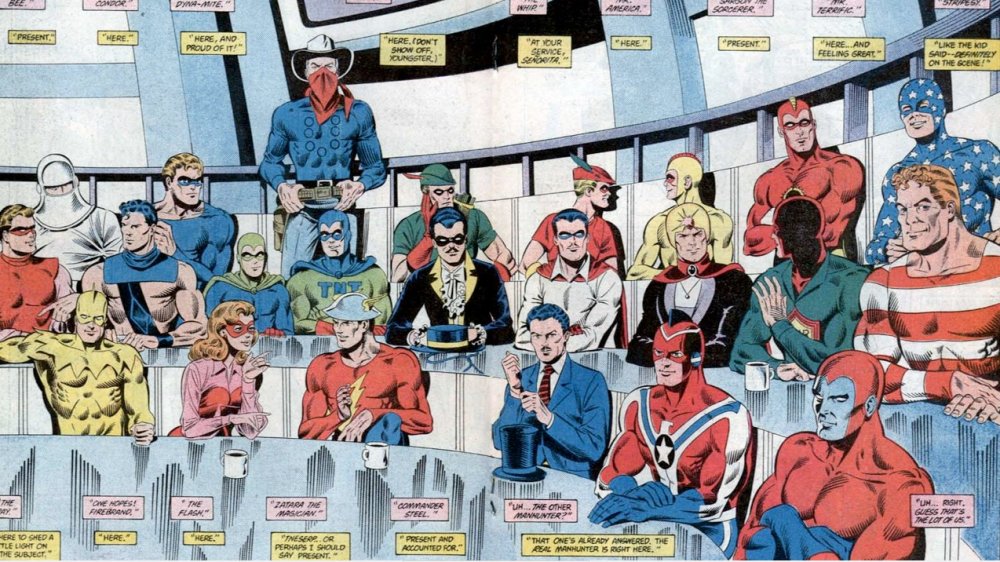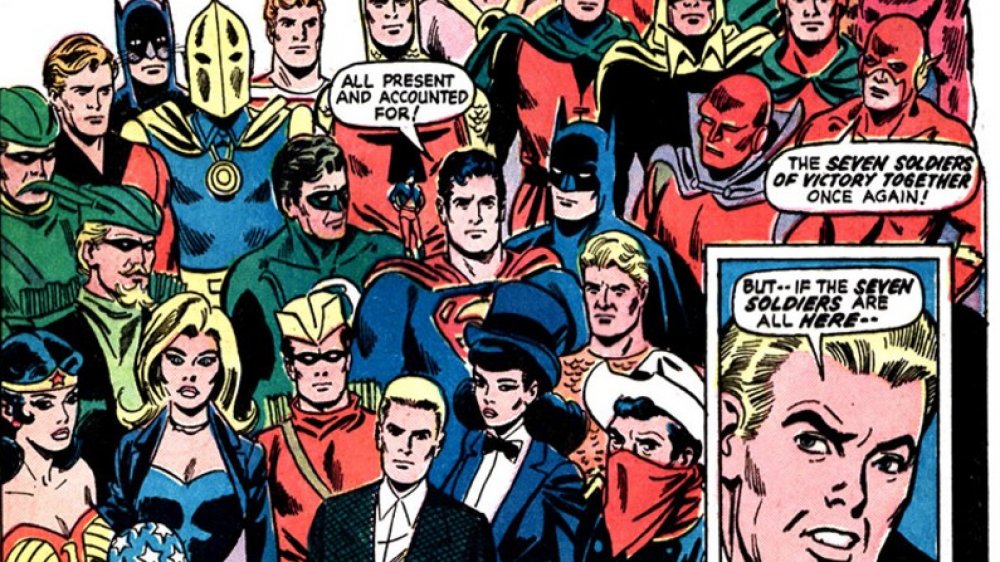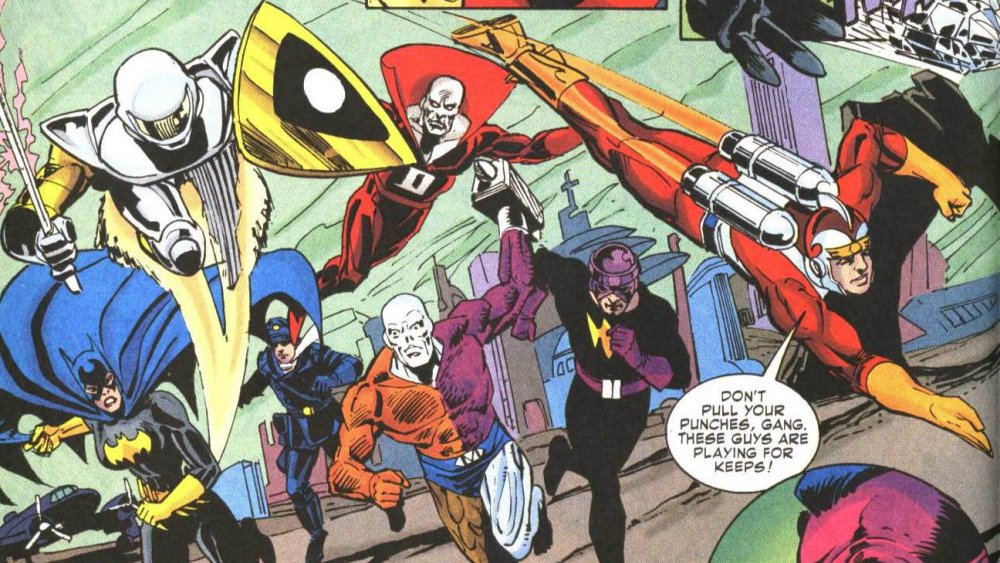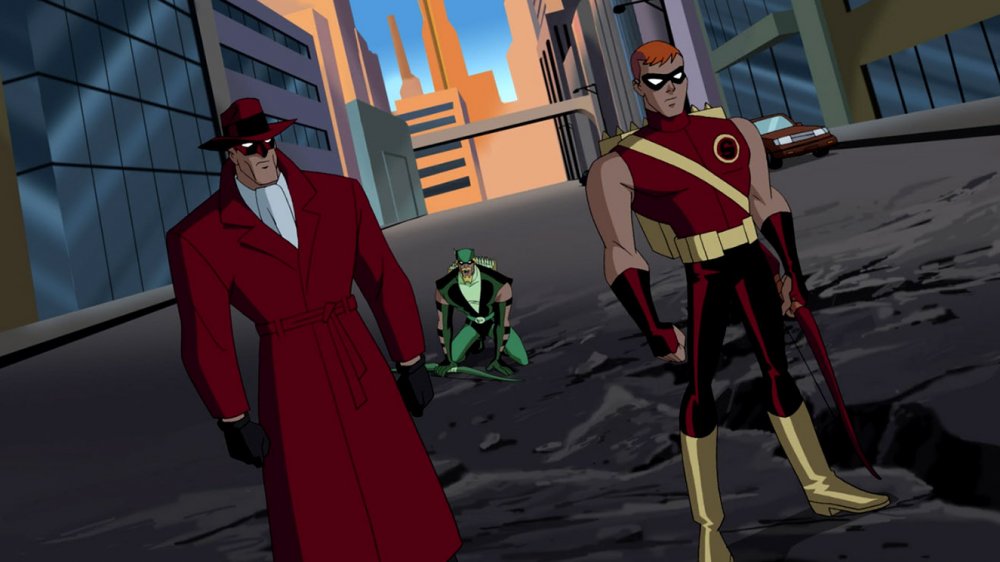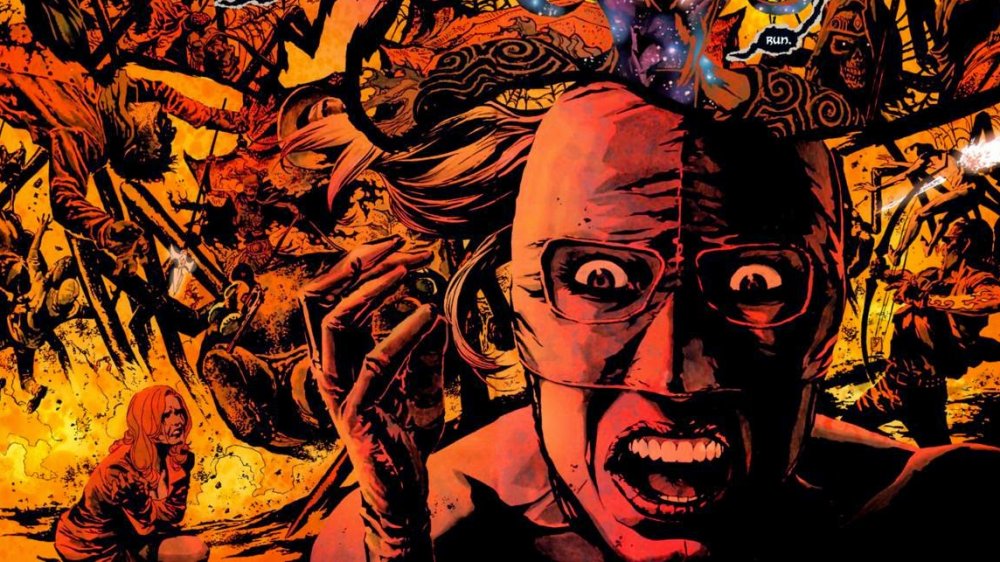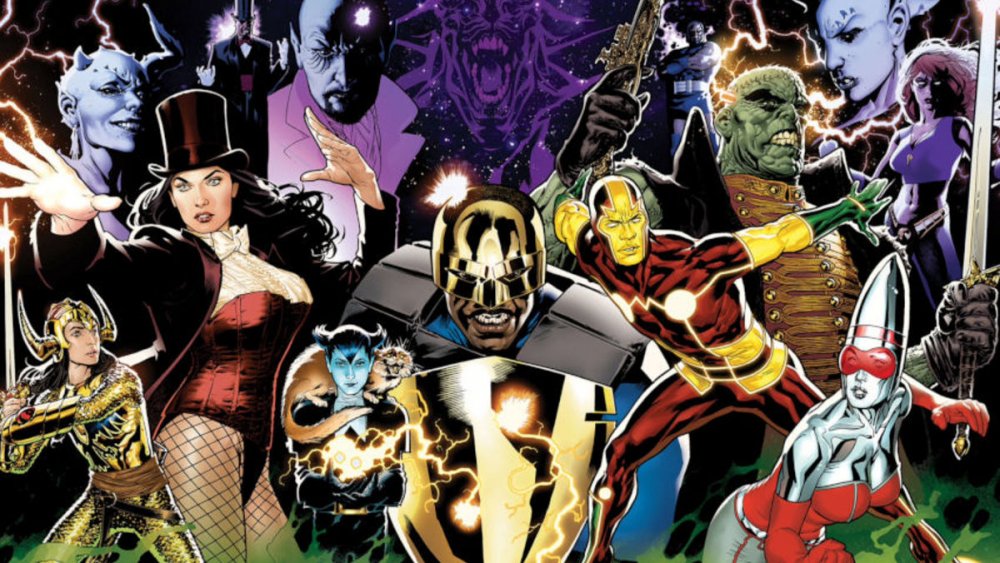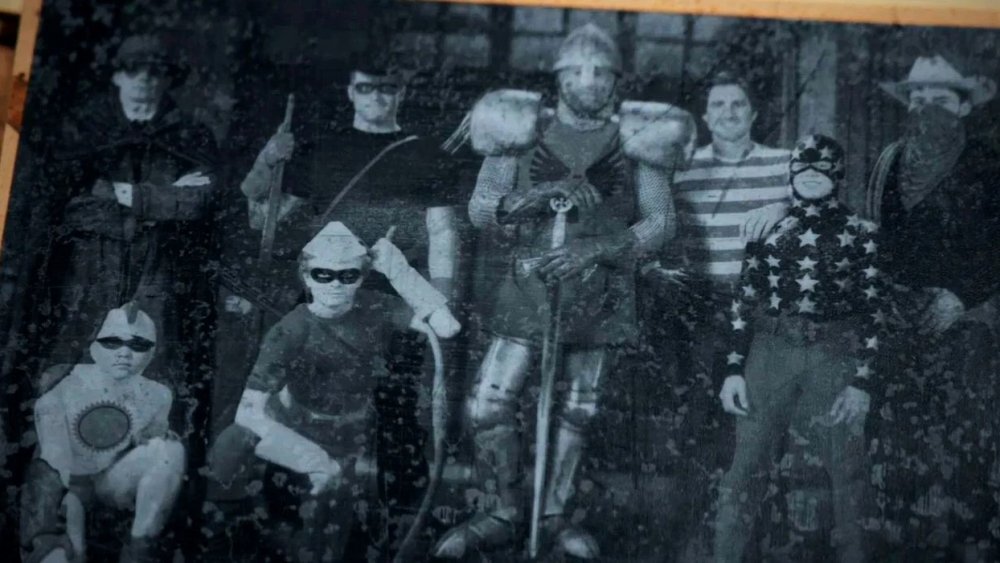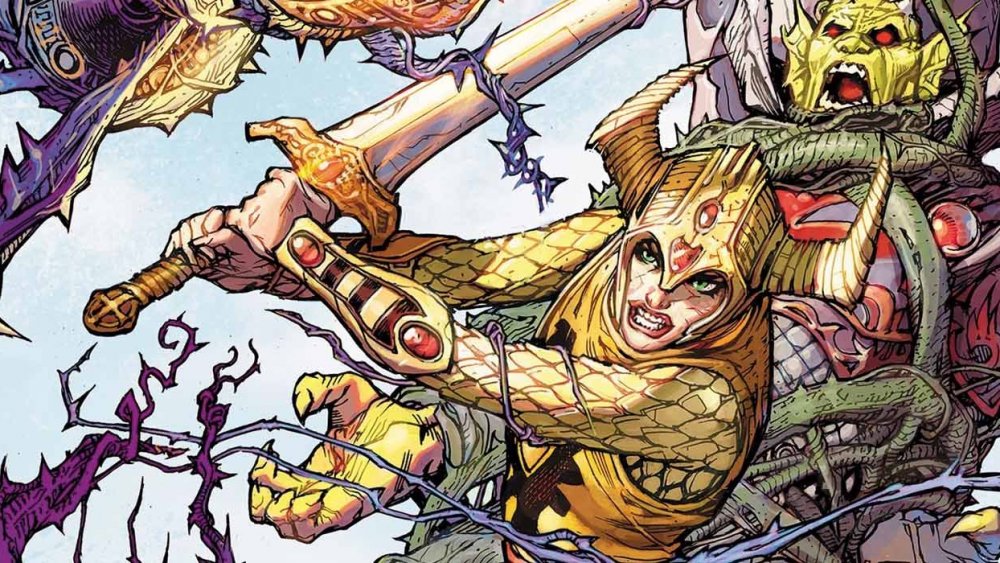DC's Seven Soldiers Of Victory Explained
One of the best results of the modern era's unquenchable love for superhero media has been the revival of obscure characters. A prime example is the DC Comics superhero team, the Seven Soldiers of Victory.
First appearing at the outset of World War II, the Seven Soldiers are a classic line-up of star-spangled do-gooders. They have continued to pop up throughout the DC canon in the decades since their debut, and have undergone some radical changes. Though the team began as a Golden Age gathering of lesser-known heroes, the 21st-century has dramatically altered them. In one particularly beloved modern take on the team, the members never even meet each other. But if there's any trait that all versions of the Seven Soldiers share, it's that they tend to not stick around for very long.
The Seven Soldiers of Victory haven't made the biggest of splashes in superhero history, but when they show up, they make it worth your while. And who knows? The team has enjoyed some prominent appearances in popular animated and live-action TV shows as of late — they could be the next Guardians of the Galaxy. In the hopes that their time to shine is nigh, and in simple appreciation of their coolness, this is DC's Seven Soldiers of Victory, explained.
The Golden Age team
The Seven Soldiers of Victory, created by Mort Weisinger and Mort Meskin, premiered in 1941's Leading Comics #1. Believing he has less than a month to live, the villain known as the Hand springs four other villains from prison. He summons the crooks to his home and tasks them with carrying out "foolproof schemes" he doesn't have time to unveil himself. The Hand then offers a challenge to the heroes Vigilante, Shining Knight, Crimson Avenger, Green Arrow, and the Star-Spangled Kid, to participate in the "greatest criminal chase in history." All five heroes respond, with two sidekicks in tow: Star-Spangled Kid's sidekick Stripesy, and Green Arrow's sidekick Speedy. Each hero had appeared previously in anthology titles like Action Comics and Detective Comics – seeing them brought together was sure to have been a real thrill for kids of the '40s.
The Soldiers defeat the Hand and his villainous recruits, but that isn't the end of the Seven Soldiers. The team's adventures continue to be chronicled in the pages of Leading Comics, including their clashes with Dr. Wilfred Doome and his time-snatched tyrants, the Black Star and his hordes of enlarged animals, and the purple-clad Mr. X. The Seven Soldiers made their final Golden Age appearance in 1945's Leading Comics #14. After that, Leading Comics changed to an all-humor format, featuring mainly talking animal characters like Peter Porkchops and Nero Fox.
The sidekicks
One of the things that sets the Golden Age version of the Seven Soldiers apart from other superhero teams of just about any era is the presence of multiple sidekicks. Green Arrow is joined by young Roy Harper, AKA Speedy, while the Star-Spangled Kid brings along his adult sidekick, Stripesy. That already makes almost a full third of the team sidekicks, and that percentage goes up with the arrival of Wing, Crimson Avenger's sidekick. The yellow-and-red clad Wing doesn't appear when the team first forms in Leading Comics #1, but he shows up here and there during the rest of the Soldiers' time in Leading Comics and is considered the unofficial eighth member of the Seven Soldiers. Many of the Soldiers' adventures feature them splitting up to tackle separate but connected threats, with the sidekicks assisting their more capable counterparts. These guys aren't just present — they're essential.
When Crimson Avenger first appeared in 1938's Detective Comics #20, he was a fairly obvious rip-off of the more well-known Green Hornet. Just like the Hornet's valet Kato, Wing first appears as Crimson Avengers' chauffeur. Wing's depiction in Leading Comics is one of the more regrettable aspects of these early stories — he's an offensive caricature of Asian people. Modern creators take note: Give Wing the revamp he deserves!
A different Green Arrow
Eight successful seasons of CW's Arrow have helped make Oliver Queen, AKA Green Arrow, a much more well-known superhero than he once was. But the Green Arrow and Speedy of the Seven Soldiers of Victory are a whole lot different from the grim vigilantes of Arrow — and from the characters as they would go on to exist in the pages of DC Comics.
The original Oliver Queen has a lot in common with Batman. He has an alter-ego as a rich playboy, and his adventures include themed tools like the Arrowcar and, yes, the Arrowcave. He also enjoys the assistance of a young ward: Roy Harper, AKA Speedy, an orphan boy with serious skills. While Green Arrow's first appearance in 1941's More Fun Comics #73 is in a back-up story, the emerald archer soon became the title's cover feature.
Unlike Bruce Wayne, Oliver Queen's transformation has nothing to do with murdered parents. In 1943's More Fun Comics #89 we learn that Queen grew up on a Native American reservation, where he learned archery and started collecting Native American artifacts. After art thieves burn down his collection, he travels to the fabled Lost Mesa, where he finds Roy, imprisoned there by the same thieves. Queen has walked into a trap — but of course, the pair join forces and use their impressive archery skills to escape. Thus, their heroic partnership was born.
The All-Star Squadron
In 1981, a new team emerged at DC Comics. While its concept was new, its setting was decades old. Most notably, it gave the Seven Soldiers of Victory a new lease on life.
Set in the parallel universe of Earth-Two, President Franklin Delano Roosevelt needs America's superheroes to help keep things safe at home. After the bombing of Pearl Harbor, he brings together members of the Justice Society of America, the Freedom Fighters, the Seven Soldiers of Victory, and a smattering of unaffiliated heroes to form the All-Star Squadron. They first appeared in a special insert of 1981's Justice League of America #193, and later that year, the team's own title premiered.
While World War II brings together the All-Star Squadron, its heroes aren't used to fighting the Axis overseas. On Earth-Two, Adolf Hitler controls an artifact called the Spear of Destiny — reportedly the same spear that stabbed Jesus Christ at the crucifixion — that will take mental control of any superhero who gets too close to the Axis' sphere of influence. Thus, the All-Star Squadron tackles threats at home, including saboteurs and spies.
The Seven Soldiers return
Decades after their last Leading Comics appearance, the Seven Soldiers returned for an adventure with both the Justice Society and the Justice League.
Starting with 1972's Justice League of America #100, the Justice League travels to Earth-Two to help the JSA, who are facing the Seven Soldiers' old enemy, the Hand. The heroes are sure the Seven Soldiers are the key to defeating the villain now known as the Iron Hand, and through magical means, learn that the team was scattered through history after battling the villain Nebula Man. The JSA and JLA split up to find the time-tossed Soldiers, discovering most of them are either transformed, have lost their memory, or are being mistaken for other legendary figures: Green Arrow, lost in medieval England, is assumed to be Robin Hood, while Speedy is trapped in ancient Greece and has been changed into a centaur.
Sadly, not all the Soldiers have survived. Prompted by the mystic image of a grave for someone called the "Unknown Soldier of Victory," some of the heroes go in search of this figure. Eventually, they learn that the grave contains the remains of Wing, who sacrificed himself in the fight against Nebula Man.
The Silver Age Soldiers
At the turn of the century, the Seven Soldiers of Victory enjoyed an all-too-brief rebirth with a drastically changed roster. In 2000, DC Comics debuted a 12-part story arc called Silver Age involving the Injustice League taking over the bodies of their heroic counterparts. In Silver Age: Showcase #1, the undead Deadman learns of the Injustice League's plans and forms a new version of the Seven Soldiers to intervene. This team includes the Shining Knight, though it's a different version of the hero from the Golden Age roster. The other heroes are space-faring Adam Strange, psychic Mento, shape-shifting Metamorpho, Major Blackhawk of the Blackhawk Squadron, and Batgirl.
One of the more interesting aspects of this team-up is that most of the Soldiers don't know there are seven members. Since Deadman can't be seen or heard without possessing someone, he recruits the other heroes by possessing friends, family, lovers, and even strangers to warn them of the Injustice Society's plans. By the end of the story, none of them are even aware that Deadman is one of their number.
Their first mission isn't much of a success: The Soldiers battle the Injustice League on the distant planet Rann, but are transported back to Earth before they can achieve victory. While the comic ends with Deadman thinking that "maybe the team has a future after all," this particular version of the Seven Soldiers doesn't appear again.
The Seven Soldiers on Justice League Unlimited
One of the coolest things about the '00's animated series Justice League is how many DC obscurities are packed into every episode. For example, in Justice League's "The Terror Beyond," the series pays tribute to Marvel's Defenders by using Aquaman, Doctor Fate, and Solomon Grundy as stand-ins for the Defenders' founding members, Namor, Doctor Strange, and the Hulk. Similarly, in the Justice League Unlimited episode "Patriot Act," the series tips its hat to the Seven Soldiers of Victory.
Early in the episode, Mr. Terrific sends the last available Leaguers to replace Superman at a Metropolis parade. The line-up includes Vigilante, Green Arrow, and the Shining Knight. Stargirl replaces the Star-Spangled Kid, and instead of Stripesy, Pat Dugan dons his powered armor as S.T.R.I.P.E. The parade is interrupted by General Eiling, who has used an experimental serum to make him a Hulk-like behemoth in the hopes of publicly beating up Superman. After Green Arrow calls for back-up, Mister Terrific sends the only reserve members he can find: Crimson Avenger and Speedy.
Unfortunately, these Seven Soldiers aren't enough to physically match General Eiling. Shining Knight is the last hero standing, and Eiling takes him out without much difficulty. It's the citizens of Metropolis who get Eiling to leave: A group of them surround the unconscious Shining Knight and stand up to the monster. Eiling leaves, still hoping to lock horns with Superman eventually.
The short life of 2005's Seven Soldiers
Back in 2005, DC Comics published a series called Seven Soldiers, written by comics superstar Grant Morrison and illustrated by a variety of artists. The series spans seven different miniseries, concluding in the Seven Soldiers of Victory #1 one-shot. Before any of these miniseries began, however, fans are introduced to a new Seven Soldiers team, who live and die in a single issue: Seven Soldiers of Victory #0.
In this issue, the original Vigilante gathers a new team of Soldiers to hunt what he calls the Buffalo Spider. The old cowboy is forced to scrape the bottom of the barrel as far as superheroes are concerned, and he doesn't quite get a full seven soldiers. He recruits Spyder, the Whip, Gimmix, the teenage Boy Blue, the wannabe Dyno-Mite Dan, and Bulleteer.
Bulleteer chickens out,which turns out to be the right decision. Vigilante's new team hunts down the Buffalo Spider at Miracle Mesa and kill it, only to learn it was bait. An army of the Sheeda, deadly aliens from the future, emerge from a portal, announcing that "the harrowing has begun." Almost all of the heroes are slaughtered by the Sheeda, though Spyder is revealed to have survived later in the event, and Vigilante pops up alive and well in the 2019 miniseries Superman's Pal Jimmy Olsen.
Grant Morrison's Seven Soldiers
Most of the 2005 Seven Soldiers event unfolds in its seven four-issue miniseries, each following a different member of the titular team: Zatanna, Mister Miracle, Frankenstein, Guardian, Bulleteer, Klarion the Witch Boy, and Shining Knight. Many of these heroes, like Guardian and Shining Knight, are reimagined versions of older, dormant characters. Continuity-wise, the hero most untouched by this new story is Zatanna, who is still haunted by the death of her father during the 1985 Crisis on Infinite Earths event. Each series has a different art team, and each character's journey culminates in Seven Soldiers of Victory #1 — though by the series' end, most of the heroes never even meet each other.
While the event didn't result in a new ongoing title for the Seven Soldiers, it had a major impact. Seven Soldiers remains one of the most uniquely structured superhero comic books ever created, being specifically designed so that fans could skip as many titles as they wanted and still feel satisfied. The Frankenstein character enjoyed quite a bit of popularity among fans, scoring the short-lived ongoing series Frankenstein, Agent of S.H.A.D.E., as well as becoming a member of Justice League Dark.
The Seven Soldiers of Stargirl
The first season of Stargirl contains live-action depictions of three of the Seven Soldiers of Victory — a thrill indeed for fans of this obscure super team. Their history, however, is portrayed a bit differently from the comics.
The stepfather of Stargirl's titular hero is Pat Dugan, who we learn was a member of both the Seven Soldiers of Victory and the Justice Society of America as Stripesy. In the Soldiers, he was sidekick to the Star-Spangled Kid, but the Kid later became Starman and was seemingly murdered along with most of the JSA by the Injustice Society. No longer calling himself Stripesy, Dugan builds himself a huge suit of mechanical armor he calls S.T.R.I.P.E. The final Soldier we meet is Justin, the Shining Knight, who now works as a janitor at Blue Valley High and is often confused about who he is.
We eventually learn Justin journeyed to Blue Valley to kill the Dragon King. This journey resulted in him having his mind scrambled by the psychic villain Brainwave. Though we see an old black-and-white photo of the team that includes the entire Golden Age roster — even the unofficial eighth member, Wing — we don't know the fate of the other Soldiers. Toward the end of Stargirl's season one finale, Justin leaves Blue Valley in search of his other teammates.
The Shining Knight
There have been a few different versions of the Shining Knight in DC Comics. We meet Sir Justin in 1941's Adventure Comics #66. As the newest member of King Arthur's Knights of the Round Table, Sir Justin is on a mission when he encounters the wizard Merlin trapped by a witch's spell. As a reward for freeing him, Merlin uses his magic to make Justin's armor invulnerable and his sword able to cut through anything. Justin and his flying horse Winged Victory are frozen during a battle with an ogre, and are reawakened in 1941.
Gardner Grayle's time as the Shining Knight is significantly shorter. In 2000's Silver Age: Showcase #1, he joins the new team of Seven Soldiers on their mission to Rann in his experimental armor. Later, he creates a new set of armor and begins to call himself the Atomic Knight.
The Shining Knight of the 2005 Seven Soldiers event is not Justin, but a woman named Ystina. In Seven Soldiers: Shining Knight #1, we learn she is the only surviving member of Arthur's Round Table, having fallen into a magical pool that transported her to the present day.
In DC's New 52 reboot, Ystina is reintroduced as a genderfluid character. In 2013's Demon Knights #14, when Exoristos shows interest in Ystina, the knight responds, "I'm not just a man or a woman. I'm both."
